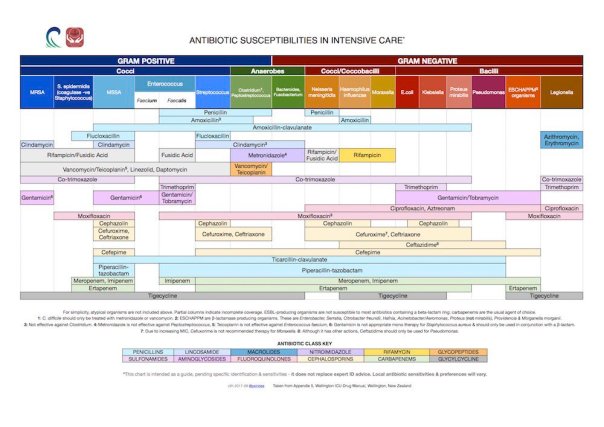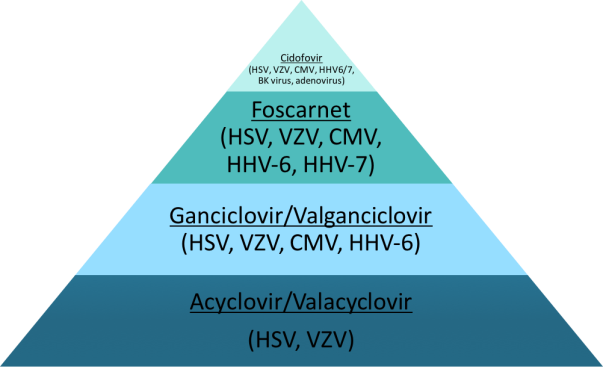One of the most difficult concepts to understand is the spectrum of activity of different antimicrobials. We are all taught each antimicrobial in silos of the other ones and I always found it difficult to create conceptual charts in my head. Thankfully, I’ve found some amazing charts on the internet (from reputable sources, of course) that shows antimicrobials in relation to one another that may be helpful to you.
Here, I will present the best ones I’ve found so far for antibiotics, antivirals, and antifungals for you to use as a reference guide. At the bottom, I will list a few caveats to take into account when using these charts, because as always, ID is never as simple as the charts imply.
Antibiotics
 Intensive Care Drug Manual: Wellington ICU. Appendix 5.
Intensive Care Drug Manual: Wellington ICU. Appendix 5.
Re-writing the fine print of the chart in case it’s not easily readable:
*For simplicity, atypical organisms are not included above. Partial columns indicate incomplete coverage. ESBL-producing organisms are not susceptible to most antibiotics containing a beta-lactam ring; carbapenems are the usual agent of choice.
1: C. difficile should only be treated with metronidazole or vancomycin
2: ESCHAPPM are β-lactamase producing organisms. These are Enterobacter, Serratia, Citrobacter freundii, Hafnia, Acinetobacter/Aeromonas, Proteus (not mirabilis), Providencia & Morganella morganii. See my 1st post on SPICE organisms for more info.
3: Not effective against Clostridium
4: Metronidazole is not effective against Peptostreptococcus
5: Teicoplanin is not effective against Enterococcus faecium
6: Gentamicin is not appropriate mono therapy for Staphylococcus aureus & should only be used in conjunction with a β-lactam
7: Due to increasing MIC, Cefuxorime is not recommended therapy for Moraxella
8: Although it has other actions, Ceftazidime should only be used for Pseudomonas
*This chart is intended as a guide, pending specific identification & sensitivities – it does not replace expert ID advice. Local antibiotic sensitivities & preferences will vary.
My notes:
Clindamycin — Community-acquired MRSA strains have been found to be resistant to clindamycin and thus, this is often not a safe option for empiric therapy against MRSA.
Rifampin – usually used as an adjunct with another antibiotic against most infection. Would not recommend its use in isolation against infections.
Co-trimazole/Trimethoprim – would not use against enterococcus or empirically against MRSA in the hospital/ICU
Moxifloxacin — has some anaerobic coverage while levofloxacin and ciprofloxacin do not.
Metronidazole – no longer the 1st choice for C.diff infection. Instead, use PO vancomycin or PO fidaxomicin. (Thanks to a commenter for pointing that out to me!)
Antivirals
This chart was made by me but inspired by Aliyah Baluch, MD, Msc from USF who did an amazing review of antimicrobials used in stem cell transplant recipients. I thought it was a great way to demonstrate the spectrum of activity of antivirals and I hadn’t seen anything similar prior to that. Check out IDpodcasts.net for other lectures on ID topics.
*This chart only covers the herpes virus family, and does not include other virus families
*Just because foscarnet and cidofovir are considered the most broad-spectrum of the bunch does not mean they are always the best options. These drugs are quite toxic and should only be used in special circumstances, often with the involvement of an ID specialist.
Antifungals
This is a great chart taken from a wonderful review on antifungals from Mayo Clinic Proceedings.
 Lewis, R.E. Mayo Clin Proc 2011
Lewis, R.E. Mayo Clin Proc 2011
References:
1.Lewis, R.E. (2011). Current Concepts in Antifungal Pharmacology. Mayo Clinic Proceedings. 86(8):805-817. DOI: 10.4065/mcp.2011.0247
2.IDpodcasts.org: Bugs, Drugs, and Stem Cells podcast. July 2017. http://idpodcasts.net/podcasts/bugs-drugs-and-stem-cells/
3.Intensive Care Drug Manual: Wellington ICU. Appendix 5. Updated 2017. http://drug.wellingtonicu.com/
4.Santos, C.A.Q. (2016). Cytomegalovirus and other beta-herpesviruses. Seminars in Nephrology. 36(5): 351-361.
DOI: 10.1016/j.semnephrol.2016.05.012
5.Razonable, R.R. (2011). Antiviral Drugs for Viruses Other Than Human Immunodeficiency Virus. Mayo Clinic Proceedings. 86(10): 1009–1026. DOI: 10.4065/mcp.2011.0309
Peer-reviewed by Jeffrey Pearson, 2nd year pharmacy resident

I would just point out the most recent IDSA recommend PO Vancomycin or Fidaxomycin over metronidazole for C Diff.
LikeLiked by 1 person
Yes, that is true! Thanks for pointing that out. Will update the post to reflect the changes. Thanks!
LikeLike
These are fantastic, thank you! Can never remember the antifungal coverage
LikeLike